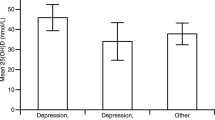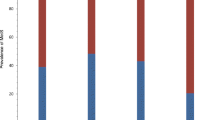Abstract
Vitamin D is traditionally recognized for its role in bone mineralization but recent observations suggest additional pertinent functions in neuronal biology. The present study examines the rate and pattern of Vitamin D deficiency in the outpatient mental health clinic of a community teaching hospital as well as the vitamin D supplementation practices of outpatient psychiatrists. Participants include 148 consecutive psychiatric outpatients. Individuals with conditions that alter the metabolism of vitamin D were excluded from the study as are those who may be taking medications that influence Vitamin D metabolism. Statistical analysis was performed using the SPSS 25th edition, statistical significance set at p < 0.05. The majority of patients in the study were between 41 and 65 years old (n = 91, 61.5%), African American (n = 120, 81.1%) and female (n = 80, 54.1%). The median level is 23.7 ng/ml. As defined by the Endocrine Society’s Clinical Practice Guidelines, 68.2% of the population had insufficient and deficient Vitamin D levels (32.4% and 35.8% respectively), 62.4% of whom were not prescribed any Vitamin D supplementation and of this untreated group, 84% were African Americans. No clinical or demographic characteristics showed any statistical difference in both the “treated” and “not treated groups”. Logistic regression did not reveal any significant predictors for Vitamin D deficiency. Vitamin D deficiency remains a significant issue among patients with psychiatric disorders. Our findings show gaps in Vitamin D deficiency treatment and recommend that future studies examine physician prescription practices in light of the racial disparity in Vitamin D deficiency treatment oberved in this study.

Similar content being viewed by others
References
Eyles DW, et al. Developmental vitamin D deficiency causes abnormal brain development. Psychoneuroendocrinology. 2009;34(Suppl 1):S247–57.
Zeng Q, Dellenbaugh T, Maldonado M, Moon J, Hornstra R. Vitamin D status of psychiatric inpatients at a community teaching hospital in the Midwest. Nord J Psychiatry. 2016;70(3):208–14.
Balabanova S, Richter HP, Antoniadis G, Homoki J, Kremmer N, Hanle J, et al. 25-Hydroxyvitamin D, 24, 25-dihydroxyvitamin D and 1,25-dihydroxyvitamin D in human cerebrospinal fluid. Klin Wochenschr. 1984;62(22):1086–90.
Gascon-Barre M, Huet PM. Apparent [3H]1,25-dihydroxyvitamin D3 uptake by canine and rodent brain. Am J Phys. 1983;244(3):E266–71.
DeLuca HF. Evolution of our understanding of vitamin D. Nutr Rev. 2008;66(10 Suppl 2):S73–87.
Cebeci AN, Ekici B. Epilepsy treatment by sacrificing vitamin D. Expert Rev Neurother. 2014;14(5):481–91.
Fraser DR, Vitamin D. Vitamin D. Lancet. 1995;345(8942):104–7.
Samaniego EA, Sheth RD. Bone consequences of epilepsy and antiepileptic medications. Semin Pediatr Neurol. 2007;14(4):196–200.
Wang Y, Zhu J, DeLuca HF. Where is the vitamin D receptor? Arch Biochem Biophys. 2012;523(1):123–33.
Pike JW, Meyer MB. The vitamin D receptor: new paradigms for the regulation of gene expression by 1,25-dihydroxyvitamin D(3). Endocrinol Metab Clin N Am. 2010;39(2):255–69 table of contents.
Prüfer K, Veenstra TD, Jirikowski GF, Kumar R. Distribution of 1,25-dihydroxyvitamin D3 receptor immunoreactivity in the rat brain and spinal cord. J Chem Neuroanat. 1999;16(2):135–45.
Lips P. Vitamin D physiology. Prog Biophys Mol Biol. 2006;92(1):4–8.
Fong CY, Kong AN, Poh BK, Mohamed AR, Khoo TB, Ng RL, et al. Vitamin D deficiency and its risk factors in Malaysian children with epilepsy. Epilepsia. 2016;57(8):1271–9.
Shellhaas RA, Joshi SM. Vitamin D and bone health among children with epilepsy. Pediatr Neurol. 2010;42(6):385–93.
Kim SH, Lee JW, Choi KG, Chung HW, Lee HW. A 6-month longitudinal study of bone mineral density with antiepileptic drug monotherapy. Epilepsy Behav. 2007;10(2):291–5.
McCue RE, et al. Vitamin d deficiency among psychiatric inpatients. Prim Care Companion CNS Disord. 2012;14(2).
Holick MF, Binkley NC, Bischoff-Ferrari HA, Gordon CM, Hanley DA, Heaney RP, et al. Evaluation, treatment, and prevention of Vitamin D deficiency: an Endocrine Society clinical practice guideline. J Clin Endocrinol Metab. 2011;96(7):1911–30.
Mulcahy KB, Trigoboff E, Opler L, Demler TL. Physician prescribing practices of vitamin D in a psychiatric hospital. Innov Clin Neurosci. 2016;13(5–6):21–7.
Rylander M, Verhulst S. Vitamin D insufficiency in psychiatric inpatients. J Psychiatr Pract. 2013;19(4):296–300.
Graham KA, Keefe RS, Lieberman JA, Calikoglu AS, Lansing KM, Perkins DO. Relationship of low vitamin D status with positive, negative and cognitive symptom domains in people with first-episode schizophrenia. Early Interv Psychiatry.
Toffanello ED, Sergi G, Veronese N, et al. Serum 25-hydroxyvitamin D and the onset of late-life depressive mood in older men and women: the Pro.V.A. study. J Gerontol A Biol Sci Med Sci. 2014;69(12):1554–61.
Polak MA, Houghton LA, Reeder AI, Harper MJ, Conner TS. Serum 25-hydroxyvitamin D concentrations and depressive symptoms among young adult men and women. Nutrients. 2014;6(11):4720–30.
Spedding S. Vitamin D and depression: a systemic review and meta-analysis comparing studies with and without biological flaws. Nutrients. 2014;6:1501–18.
Kalueff AV, Tuohimaa P. Neurosteroid hormone vitamin D and its utility in clinical nutrition. Curr Opin Clin Nutr Metab Care. 2007;10:12–9.
Author information
Authors and Affiliations
Corresponding author
Ethics declarations
Ethical Approval
All procedures performed in studies involving human participants were in accordance with the ethical standards of the Interfaith Medical Center, Institutional Review Board and with the 1964 Helsinki declaration and its later amendments or comparable ethical standards.
Additional information
Publisher’s Note
Springer Nature remains neutral with regard to jurisdictional claims in published maps and institutional affiliations.
Rights and permissions
About this article
Cite this article
Jegede, O., Gayam, V., Gunasekara, R. et al. Patterns of Vitamin D Deficiency in a Community Outpatient Psychiatric Practice: a Real-World Evaluation of Treatment Gaps. Psychiatr Q 91, 561–570 (2020). https://doi.org/10.1007/s11126-020-09720-x
Published:
Issue Date:
DOI: https://doi.org/10.1007/s11126-020-09720-x




